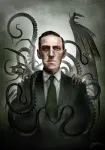Blind Read Through: J.R.R. Tolkien; The Silmarillion, Akallabêth, part 2
“In this Age, as is elsewhere told, Sauron arose again in Middle-earth, and grew, and turned back to the evil in which he was nurtured by Morgoth, becoming mighty in his service. Already in the days of Tar-Minastir, the eleventh King of Númenor, he had fortified the land of Mordor and had built there the Tower of Barad-Dûr, and thereafter he strove ever for dominion of Middle-earth, to become a king over all kings and as a god unto Men.“
Welcome back to another Blind Read! This week we continue the story of Númenór and watch as they create cancer within themselves, eventually leading to their demise.
We left off last time with the Númenóreans hitting landfall in Middle-earth, so they could hold to their word that they would not sail East towards Valinor.
The people of Middle-earth “sat under the Shadow were now grown weak and fearful,” but the Númenóreans taught them to farm and trained them “in the hewing of wood and the shaping of stone.“
This enabled the people of Middle-earth to forget their ancestor’s transgressions and shed Morgoth’s taint. They revered the Númenóreans because of this and took them as godlike kings.
This power went to their heads. “And they said among themselves: ‘Why do the Lords of the West sit there in peace unending, while we must die and go we know not whither, leaving our home and all that we have made? And the Eldar die not, even those that rebelled against the Lords. And since we have mastered all seas, and no water is so wild or wide that our ships cannot overcome it, why should we not go to Avallónë and greet our friends?‘”
The sentiment of Hubris is central to the Númenórean downfall and the wars which would follow in the Second and Third ages. The Dúnedain thought themselves so great and powerful that they allowed their demise. There is a very close parallel with the Romans in the Númenórean storyline, and I have to wonder if Tolkien didn’t model their rise and fall after that ancient empire. We’ll touch on that more later.

Some heavy theology follows the above quote, which spans pages. It is Tolkien’s search for meaning between the godlike and the mortal. There is quite a bit of documentation that Tolkien eventually meant for these histories to progress into later ages, which would become our history, almost like alternate history and mythology to the real Earth. Because of this, we see this Theology in the struggle of suffering. Why do Men have to suffer and die when the Elves and Valar live eternally? These are surrogate Angels of our world, with Ilúvatar being God.
They go back and forth, showing the youth and entitlement the Númenóreans felt. Why shouldn’t they get to see Valinor and become undying like the rest? But the Valar argued with them, telling them they were given their own gifts; they were not allowed to have the gifts of the Valar and the Eldar.
The Númenóreans all believed this, so it wasn’t until Tar-Atanamir (King of the Dúnedain) that their quest for eternal life saw its first downfalls (which they were blind to) because “Atanamir lived to a great age, clinging to his life beyond the end of all joy; and he was the first of the Númenóreans to do this, refusing to depart until he was witless and unmanned.”
The curse they would keep was this obtuseness of desire. Instead, they would cling to power and life to the detriment of all else.
It was during this age that they built significant structures on the mainland. Many of the Númenóreans reveled in the worship they received from the men of Middle-earth, “and the power and majesty of their kings were increased; and they drank, and they feasted, and they clad themselves in silver and gold.”
Reading this passage, I couldn’t help but think of Denethor and his disgusting eating habits while Merry sang his lamentations.
But the Númenóreans had more power and prestige than Denethor, and it enabled Sauron to gain his own power. So it’s here in the book that we get this essay’s opening quote.
There are some confusing and contradictory passages here which I probably need to read a few more times to understand completely. Still, it seems as though Sauron was around and in the land building power and creating Mordor, and during the Númenórean King Tar-Minastir’s reign, he created the One Ring. It was a partnership between Tar-Minastir and Gil-Galad, the Elven King, which stopped his ascension to power. I hope to see what that struggle looks like in the last chapter of The Silmarillion, “Of the Rings of Power and the Third Age.”
His fear and hatred of them grew through his exposure to the Númenóreans. “Yet Sauron was ever guileful, and it is said that among those whom he ensnared with the Nine Rings three were great lords of the Númenórean race. And when the Úlairi arose that were the Ring-wraiths, his servants, and the strength of his terror and mastery over Men had grown exceedingly great, he began to assail the strong places of the Númenóreans upon the shores of the sea.”
Because of this struggle against Sauron and their own Hubris, the Númenóreans continued their segregation from the Eldar and Valar. It was years and numerous Kings later when they stopped taking Elvish names and stopped tending the White Tree. They didn’t strike out against the Eldar but punished those of their ranks who sympathized with the Eldar. The Valar saw this, and they “gave them counsel and protection no more in their wroth.”
Tolkien does something exciting here. It’s the telling of the rise and fall of civilization over age, but he tells it so simply that it feels like one event after another leading to their eventual fall. But these events are slow-moving, and little things happen during the reign of each of the Númenórean great Kings. Of course, Sauron was around in Middle-earth during this time. Still, his influence was slight, mainly because of the impact of Gil-Galad, but also because he was interested in building up his great fortress, much like his Valar master, Morgoth.
There was no nail in the coffin for the Númenóreans, which makes this history so believable. Great empires can withstand a single significant event. What they cannot resist is years of degradation from the inside. The Númenórean pride and hatred lead them down a path of righteous death.
These people lived hundreds of years, and we’re up to the 24th King of Númenór, and we haven’t even gotten to the linchpin event, which caused the eventual downfall. Tolkien is taking his time, creating an environment within Númenór that will allow this linchpin event to happen.
So join me next time when we see what that event is as we continue on the story of Akallabêth!







You must be logged in to post a comment.